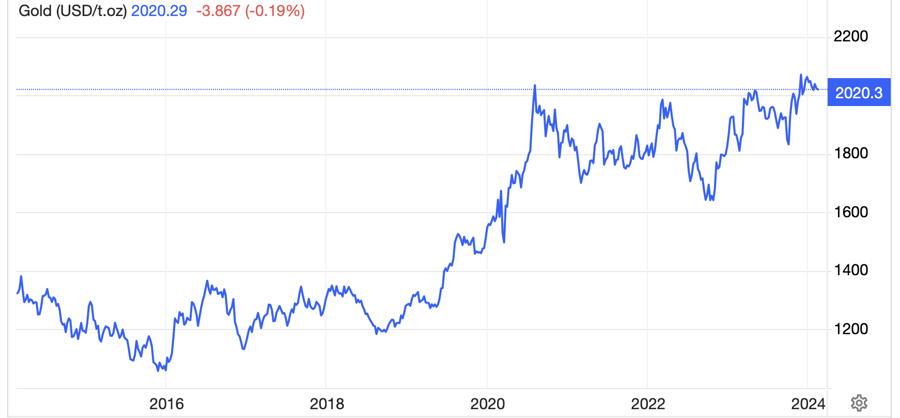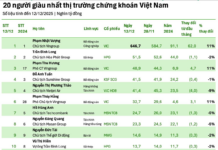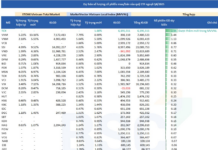Recent cautious statements from Federal Reserve officials raised the possibility of the central bank keeping interest rates higher for longer, pushing up the value of the US dollar and bond yields, putting pressure on gold prices.
At the close of the trading session on Monday (February 12), spot gold prices in the New York market fell by about $5/oz, or more than 0.2%, settling at $2,020.5/oz – according to data from Kitco Exchange. This price is equivalent to about VND 59.8 million per tael if converted at the selling rate of USD at Vietcombank.
This week, interest rate expectations will continue to be influenced by the macroeconomic data from the U.S. The most important of these is the release of the Consumer Price Index (CPI) for January, which is expected to be announced by the U.S. Department of Labor on Tuesday. In addition, there are other important data to be released on Thursday and Friday, including retail sales, industrial production, trade balance, housing starts, and the Producer Price Index (PPI).
Fluctuations in interest rate expectations will affect the exchange rate of the US dollar and U.S. bond yields, thereby affecting the price of gold – an asset valued in USD and does not carry interest.
Senior analyst Jim Wyckoff of the precious metals news site Kitco News believes that the first interest rate cut by the Fed may be pushed back to the latter half of this year, as recent statistical data shows that the U.S. economy is still too strong for the Fed to cut interest rates in May. Wyckoff further added that the attractiveness of gold is declining due to the upward trend of the U.S. stock market.
“We are expecting inflation in January to continue to decrease, and if that expectation does not materialize, the downward pressure on gold prices will increase,” Wyckoff said.
In a survey by Reuters, experts forecast that the overall CPI for January in the U.S. will increase by 0.2% compared to the previous month, while the core CPI will increase by 0.3%.

Speaking last week, a series of Fed officials – including Fed Chairman Jerome Powell – said they want to wait until they can truly trust that inflation will fall to a sustainable 2% before they begin cutting interest rates. According to data from the FedWatch Tool by the CME Exchange, traders are betting that there is about a 57% chance that the Fed will have its first interest rate cut in May.
According to Bart Melek, head strategist at TD Securities, even though the Fed has not cut interest rates, the physical demand for gold and the trend of net gold buying by central banks will be the factors that will push gold prices to an average of $2,200/oz in the second quarter of this year.
Senior analyst Krishan Gopaul of the World Gold Council (WGC) said the central banks of India and Turkey increased their gold reserves in January of this year.
In a post on social media, Gopaul said the Reserve Bank of India (RBI) bought a net 9 tons of gold last month, marking the first net purchase month since October of last year. Turkey’s official gold reserves increased by 12 tons to reach 552 tons, still only about 6% lower than the record of 857 tons set in February 2023, according to Gopaul.
Analysts closely monitor Turkey’s moves related to its gold reserves, as it was the world’s largest gold seller by central banks last year. However, since June 2023, the country has consistently bought net gold.
According to data from the WGC, central banks purchased a net 1,037 tons of gold in 2023, less than 45 tons shy of the record net purchases registered in 2022. The net gold purchases by central banks over the past 2 years are double the long-term average trend over 10 years. However, the WGC predicts that net gold purchases by this group will return to the long-term average level this year.





































